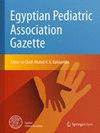The pattern and clinical outcomes of non-diabetic pediatric endocrine disorders, Al-Baha, Saudi Arabia: a retrospective study
IF 0.5
Q4 PEDIATRICS
引用次数: 0
Abstract
Abstract Purpose Pediatric endocrine disorders (PED) are a common component of medical health challenges in Saudi Arabia. We aimed to describe the pattern and clinical outcomes of different non-diabetic pediatric endocrine disorders in Al-Baha Region, Saudi Arabia, aiming for early diagnosis and management. Methods The clinical and laboratory data of 744 children and adolescents who presented with non-diabetic endocrine disorders and received medical care at the pediatric endocrine clinic et al.-Baha during the period from 2018 to 2022 were retrospectively analyzed based on the records. Results A total of 744 patients were recruited, 377 were females and 361 were males with a female/male ratio of 1.04/1. The patients’ ages ranged from 2 months to 17 years, with a mean age of 9.87 ± 4.59 years. The commonest endocrine disorders were thyroid disorders 234 (31.5%), short stature 176 (23.7%), obesity 123 (16.5%), and calcium phosphate metabolism disorders 117 (15.7%). Other disorders seen were pubertal disorders 27 (3.6%), adrenal gland disorders 22 (3%), syndromes with endocrine features 14 (1.9%), sex development and gender disorders 6 (0.8%), pituitary and hypothalamic disorders 4 (0.5%), and mixed endocrine disorders 4 (0.5%). PED is a substantial source of morbidity in 26 cases and mortality in 2 cases. Conclusions Thyroid, growth, and obesity disorders were the most common PED. Pediatric endocrine disorders have a substantial source of morbidity and mortality among Saudi children and adolescents. This baseline data is useful for planning PED care at institutional and national levels.Al-Baha,沙特阿拉伯非糖尿病儿童内分泌紊乱的模式和临床结果:一项回顾性研究
摘要目的儿科内分泌疾病(PED)是沙特阿拉伯医疗卫生挑战的共同组成部分。我们旨在描述沙特阿拉伯Al-Baha地区不同非糖尿病儿童内分泌疾病的模式和临床结果,旨在早期诊断和治疗。方法回顾性分析2018 - 2022年在儿科内分泌诊所等就诊的744例非糖尿病性内分泌疾病患儿和青少年的临床和实验室资料。结果共纳入744例患者,其中女性377例,男性361例,男女比例为1.04/1。患者年龄2个月~ 17岁,平均年龄(9.87±4.59)岁。最常见的内分泌紊乱是甲状腺紊乱234例(31.5%),身材矮小176例(23.7%),肥胖123例(16.5%),磷酸钙代谢紊乱117例(15.7%)。其他疾病有青春期疾病27例(3.6%)、肾上腺疾病22例(3%)、内分泌特征综合征14例(1.9%)、性发育和性别障碍6例(0.8%)、垂体和下丘脑疾病4例(0.5%)、混合性内分泌疾病4例(0.5%)。PED是26例发病和2例死亡的主要原因。结论甲状腺、生长和肥胖障碍是最常见的PED。儿童内分泌失调是沙特儿童和青少年发病和死亡的一个重要原因。这一基线数据有助于在机构和国家层面规划PED的治疗。
本文章由计算机程序翻译,如有差异,请以英文原文为准。
求助全文
约1分钟内获得全文
求助全文
来源期刊

Egyptian Pediatric Association Gazette
PEDIATRICS-
自引率
0.00%
发文量
32
审稿时长
9 weeks
期刊介绍:
The Gazette is the official journal of the Egyptian Pediatric Association. The main purpose of the Gazette is to provide a place for the publication of high-quality papers documenting recent advances and new developments in both pediatrics and pediatric surgery in clinical and experimental settings. An equally important purpose of the Gazette is to publish local and regional issues related to children and child care. The Gazette welcomes original papers, review articles, case reports and short communications as well as short technical reports. Papers submitted to the Gazette are peer-reviewed by a large review board. The Gazette also offers CME quizzes, credits for which can be claimed from either the EPA website or the EPA headquarters. Fields of interest: all aspects of pediatrics, pediatric surgery, child health and child care. The Gazette complies with the Uniform Requirements for Manuscripts submitted to biomedical journals as recommended by the International Committee of Medical Journal Editors (ICMJE).
 求助内容:
求助内容: 应助结果提醒方式:
应助结果提醒方式:


